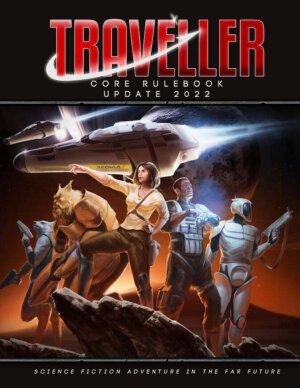
Publisher: Mongoose Publishing
Author: Matthew Sprange
Artists: Xavier Bernard, Sergio Villa, Anderson Maia, Mark Graham, Nikita Vasylchuk, Douglas Deri, Ian Stead, Ankit Yadav, Cassie Gregory, and Alessandro Rocco
Year: 2021
Genre: Latest edition of the Traveller roleplaying game corebook
Pages: 264 pages
MSRP: 59.99 in hardcover or 30.00 in PDF at DriveThruRPG
Traveller has existed as a roleplaying game since 1977, but this reviewer has no personal experience with any previous versions in which to compare the 2022 edition. Traveller is a d6 game. The book is in full color and is written clearly with colored boxes to highlight ideas or rules. It has a mixture of good classic science fiction art reminiscent of the hard science fiction cover art from the 1960s and 1970s and some weaker 3d images images for ships and vehicles. The base system tries to be universal using tech level to determine the type of game you will run.
The life path system allows players to make more experienced characters. Players will roll to see if they have mishaps, life events and promotions. They can make older characters by risking stat loss, debt, or gaining enemies. Those who want balanced characters or a balance between characters will find this off putting, but those who like randomness and backstory will enjoy creating characters from a snot nosed youth to a veteran space captain.
The corebook has three races, Aslan, Human and Vargr. The Aslan and Vargr each get a one page description, but there are no unique life paths provided with the races. Players looking for non-humanoids will be disappointed unless they get other supplements. The system assumes characters will be human by default in the Imperium.
The book has plenty of skills, which will vary in usefulness depending on the type of game played. The characters are limited to their total skill points, which is based on a characters intelligence and education. Skills are combined with a statistic that makes sense for the task. The rules basically follow a 2D6+ skill + a characteristic dice modifier + other dice modifiers. The final calculated roll must meet or exceed the difficulty number varying from routine (6+) to Impossible (16+). The margin or success or failure then determines its actual effect. The system gives examples for time frames for each task.
Combat does not require exact battle maps or distances. Theater of the mind is sufficient for most combats. Damage is based on weapon type and modified by strength for melee attacks. Damage is taken to endurance first then rolls over to strength or dexterity as determined by the player. Unconsciousness is reached when dexterity or strength reach zero. The character is dead if all three stats reach zero. Damage to all three stats can
The corebook includes simple rules for poisons and diseases, but include more detailed effects of radiation poisoning. Environmental effects such as gravity, temperature, weather, etc are briefly described.
The encounter section briefly describes alien creatures. Creatures are given hits, behaviors, size, speed, attacks and skills. The rules recommend driving off or causing an animal to go unconscious. It is refreshing to see monsters do not always fight to the death in a system. The tables for intelligent NPCs are sufficient to quickly develop a decent character for the players to meet. Those looking for detailed NPCs and an extensive beastiary will be disappointed.
The equipment tables are fairly long. The armor table should have included traits (similar to the weapons table) to determine the protection it provides rather than requiring the a reading of the description to determine what it protects against. The augmentation section is brief so those looking for a cyberpunk style game will not be happy with the selection in the corebook.
Vehicle and space combat get fairly detailed. Movement, firing angles, etc are included in the rules. This is where the game delves into wargaming and would probably be better if they spun a separate supplement/game much like Star Frontiers did with Knight Hawks for vehicle combat.
The spacecraft construction is a highlight of most space faring games. Players will spend hours optimizing and dreaming of their ideal ship. The rules are fairly simple, but do require iteration to optimize the power
Rules for psionics is provided in the game, but only with gamemaster permission. The powers are more subtle in line with Babylon 5 psi-corps rather than a superhero game. Psionic characters will be required to go through their own life path. These type of characters are not integral to the game and can be removed without issue if they do not appeal to the group.
The last few sections of the book include rules for trade and world creation. The book recommends the players handle the trade section, while the gamemaster focuses on the adventure. The world creation tables can get complex, and GMs are strongly suggested to memorize what each code on a world means.
Overall, the system will appeal to groups looking for a science fiction experience rather than science fantasy with relatively simple rules. A session zero is highly recommended to create the characters and ships before delving into play. Gamemasters will have no issue with finding supplements should they delve deeper into the game.
[rwp-review id=”0″]